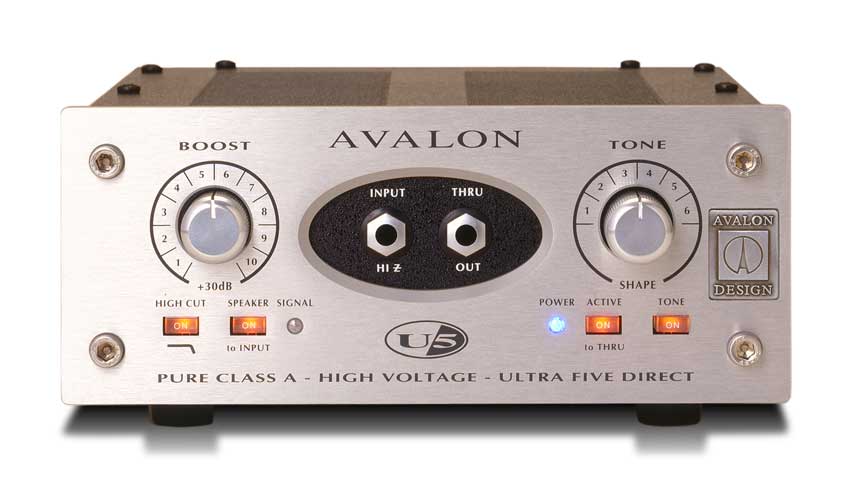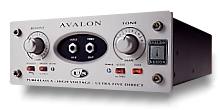
| REVIEWS: | |||||||
|
AVALON DESIGN U5
The U5 from Avalon Design proves that there can be more to Direct Injection than you might have thought. Kevin Morgan checks it out.
Let's
get down to business Avalon
has been producing non-compromised top quality audio equipment out of
their San Clemente, California base since the mid 80's. Like all Avalon
products, the U5 features pure Class A audio amplifiers and is of sturdy,
attractive, and functional appearance. It also incorporates the following
features:
Overview The U5 is built to last. Two rack spaces tall and one-half rack spaces wide the internal working of the U5 are housed in a heavy-duty steel case with a brushed-aluminum face plate. All jacks and XLR sockets are attached to the circuit board by means of flying leads, and the front panel features two control knobs for BOOST and TONE settings that are machined from solid aluminum. The BOOST gain ranges from +2dB to +32dB in ten 3dB increments and the TONE control offers six different settings that aim to improve the sonic character of individual instruments.
A major important feature of the U5 is its high input impedance of 3,000,000 Ohms. This is because that in the main, safety concerns aside, a DI boxes prime purpose is to convert a low level signal, generated by magnetic or electro-piezo pick-ups, to a Mic or Line level signal that's balanced. Now don't get me wrong as their are many good reasons for DI'ing synthesizers and other higher level signals but low level pick-up signals can be somewhere in the region of -50dB and need to be treated with a lot of respect. It is therefore important that a DI box, when amplifying a signal, dose not overload it by drawing too much current from it, and this is achieved by presenting the signal with a high or "zero load effect" input impedance like the U5 does.
It really does seem that Avalon understands the needs of the musician when it comes to DI'ing instruments. This relates to the fact that the U5 offers six different tone curves and a 400w speaker input socket. In the ideal world I would think that most musicians would prefer to Mic up their instruments in a live or recording situation. However, in the real world this is not always possible as issues like feedback and location may mean that your only option is to DI your instrument. The problem with DI'ing instruments is that you can never capture the real acoustics of the instrument like you can with a Mic. Also if you are a bass player or guitarist, then part of your sound has as much to do with your amp as it does your guitar.
In use the U5 is simply wonderful. Any signal sent through is done a justice with added warmth and clarity and it's input sensitivity is quite outstanding. The six tone bank settings, of which at first I was quite dubious of, offer seriously thought out equalization curve's that work. Three of the curves are subtle variations of a flat response and could be applied to most instruments. Setting two is for bass guitar which acts like a notch filter around 1 kHz and settings 5 and 6 feature bass roll off where 6 also offers a bit of roll off at the top end.
My
only criticism of the U5 relates to the fact that it uses DC coupling
in its circuitry. Now my problem is not with DC coupling as I understands
that using this helps retain signal depth, but the fact that it can
cause the emission of cracks and pops on the output when alterations
are made to it's setting. Therefore a nice feature would be that of
a mute button as this could save many a journey to the console or amplifier. In
Conclusion The U5 is pure Class A and this is reflected in its price. For the audio professional it is surely one of those essential pieces of kit that can make all the difference in certain situations. Those of you who seriously care about the sound you produce when you DI your equipment, you may want to consider the possibility of making the U5 a worthwhile investment.
DI
Facts Back to Reviews Index & User List |
Tel: +1 949 492 2000
©2023 Avalon Design USA LLC



